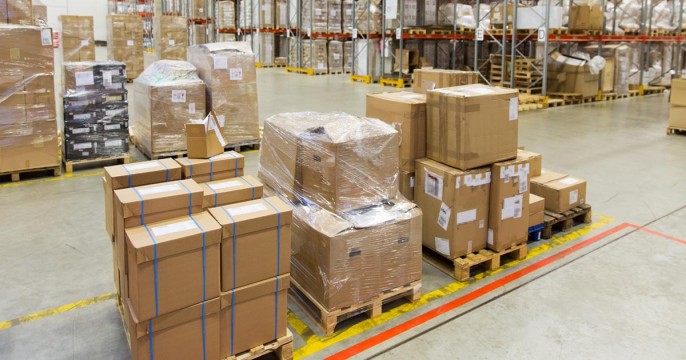If you’d like further information on any of the Pallets that we stock at Springpack, get in touch with the Packaging Experts today! You can reach us by…
How to Protect Pallets for Transit
How to Protect Pallets for Transit
Choosing effective packaging solutions and processes to protect your pallets can save you both time and money. After all, transit is the most dangerous stage of the shipping process as goods can be exposed to severe weather conditions and general transport disturbance.
You need to be confident that your goods arrive in perfect condition, so we’ve put together this guide to the essentials you’ll need to efficiently package your pallets for dispatch!
Choosing The Best Pallets
You need to select pallets which will work comfortably with the available storage space, keep transport costs to a minimum and ensure goods are handled efficiently. As well as choosing the best size for your typical load size, you’ll need to choose the best pallet material. Wood and plastic are the two most popular options and each have their own set of pros and cons.
Wooden pallets are cost-effective, easy to repair and are able to hold more weight than their plastic counterparts, however they are most susceptible to damage, particularly if they are not stored in a dry place. Plastic pallets are more durable and therefore potentially more cost-effective in the long run. They also weigh less and are weather resistant, so handling and storage is simple.
Although wooden pallets often contain nails, fasteners and splinters which can cause damage to products and make it more difficult to handle, the unique presswood pallet eliminates these issues. This is the ultimate wooden pallet as they’re manufactured without nails or screws.
Loading Pallets
Before applying protective packaging to your pallets it’s important to ensure they are loaded up properly. In fact, before doing any loading it’s best to check that the pallet itself is not damaged. A damaged pallet could impact the integrity of the load despite all your efforts to wrap and strap the load in place.
When you begin loading you should utilise the pallet footprint by distributing the weight of the goods across the surface area. If you’re working with a small dispatch you can start from the centre and work outwards to ensure the weight is spread evenly. Overloading the pallet may cause it to collapse or tip. And this is likely to lead to costly damage and time wasted.
Loads shouldn’t exceed the dimensions of the pallet, as this will prevent you from being able to wrap the load securely. Any goods overhanging are at risk of being knocked in storage or transit, ensuring the edges are protruding further than the load will mean it is the edges that take the hits should they occur.
Protecting With Stretch Wrap
Loose goods on a pallet can be dangerous for workers handling them, and leaves them at risk of damage.
There are several varieties of pallet wrap you can choose from, all of which are designed to keep goods out of harm’s way, protecting against damage, dust, dirt and moisture.
One of the most popular options is stretch wrap. The reason for this? The clue is in the name; stretch wrap is obviously great for wrapping pallets due to its stretching properties. This means that less wrap needs to be used per load, saving time and money on supplies. Using wrap dispensers makes the process even simpler and quicker to implement. An alternative to stretch wrap is shrink film . You will need a machine to apply heat to ensure everything is wrapped tightly and securely.
Whichever wrap you decide to go with, it should be first applied around the pallet base. It is then wrapped in upwards, around the load. Remember that pallet wrap is designed to stabilise the load and not secure it to the pallet. It should therefore be used in conjunction with strapping or banding.
Strapping/Banding
When preparing to send heavy goods it’s recommended that loads are not only wrapped but also strapped or banded in order to prevent any unwanted movement. This will give you peace of mind that no goods will be separated from the load and damaged.
A strap or band should be drawn tightly to the load. A manual strapping tool, or an automatic strapping machine with then ‘seal’ the strapping. A fastening method can then be applied to secure the ends, with options including seals, buckles and cable ties.
Polyester strapping is great for medium to heavy duty loads and loads that are particularly susceptible to impacts or shifting during transit, and is a popular choice for reinforcing heavy packages. However polypropylene is also a great economical. Its therefore ideal for reinforcing light to medium duty loads with short transportation trips.
What Can You Do To Protect Wooden Pallets?
There are a number of other protective packaging products that you can include in your dispatch process:
Corner protectors can increase vertical stacking strength and absorb and cushion edges. This helps to prevent any damage to a load upon impact.
Cardboard edge guards are also a great addition. They stabilise and reinforce the load, while also creating a straight edge to aid the strapping of irregularly shaped goods.
Top sheets can work in conjunction with pallet wrap to give you that extra piece of mind.
Were Here to Help Guide Inform

Author: Amy Francis
Springpack is a UK packaging company delivering sustainable solutions that empower customers. We prioritise exceptional service, building strong relationships and developing innovative packaging solutions tailored to unique needs. Sustainability drives us, from eco-friendly materials to reusable practices minimising waste and emissions. As a family-run business, we’ve grown from humble beginnings to industry forerunners. Our passion lies in making a positive impact in our community and the lives of customers, employees, and stakeholders through outstanding service that exceeds expectations.




